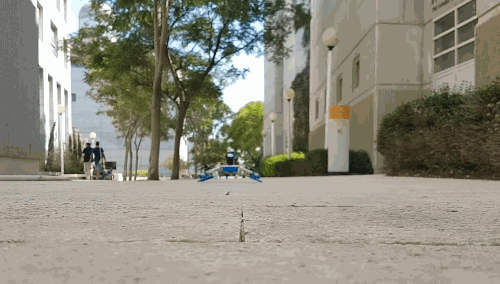There’s great potential in using both drones and ground-based robots for situations like disaster response, but generally these platforms either fly or creep along the ground. Not the “Flying STAR,” which does both quite well, and through a mechanism so clever and simple you’ll wish you’d thought of it.
Conceived by researchers at Ben-Gurion University in Israel, the “flying sprawl-tuned autonomous robot” is based on the elementary observation that both rotors and wheels spin. So why shouldn’t a vehicle have both?
Well, there are lots of good reasons why it’s difficult to create such a hybrid, but the team, led by David Zarrouk, overcame them with the help of today’s high-powered, lightweight drone components. The result is a robot that can easily fly when it needs to, then land softly and, by tilting the rotor arms downwards, direct that same motive force into four wheels.
 Of course you could have a drone that simply has a couple of wheels on the bottom that let it roll along. But this improves on that idea in several ways. In the first place, it’s mechanically more efficient because the same motor drives the rotors and wheels at the same time — though when rolling, the RPMs are of course considerably lower. But the rotating arms also give the robot a flexible stance, large wheelbase and high clearance that make it much more capable on rough terrain.
Of course you could have a drone that simply has a couple of wheels on the bottom that let it roll along. But this improves on that idea in several ways. In the first place, it’s mechanically more efficient because the same motor drives the rotors and wheels at the same time — though when rolling, the RPMs are of course considerably lower. But the rotating arms also give the robot a flexible stance, large wheelbase and high clearance that make it much more capable on rough terrain.
You can watch FSTAR fly, roll, transform, flatten and so on in the following video, prepared for presentation at the IEEE International Convention on Robotics and Automation in Montreal:
The ability to roll along at up to 8 feet per second using comparatively little energy, while also being able to leap over obstacles, scale stairs or simply ascend and fly to a new location, give FSTAR considerable adaptability.
“We plan to develop larger and smaller versions to expand this family of sprawling robots for different applications, as well as algorithms that will help exploit speed and cost of transport for these flying/driving robots,” said Zarrouk in a press release.
Obviously at present this is a mere prototype, and will need further work to bring it to a state where it could be useful for rescue teams, commercial operations and the military.
via Tech Republiq
No comments:
Post a Comment